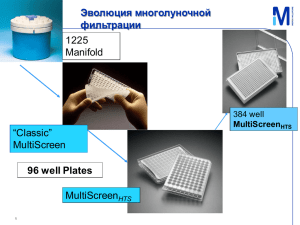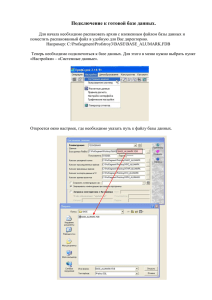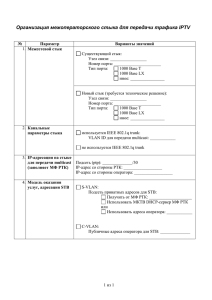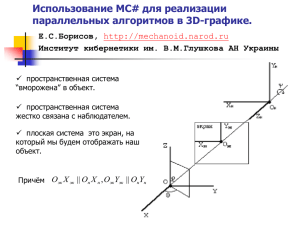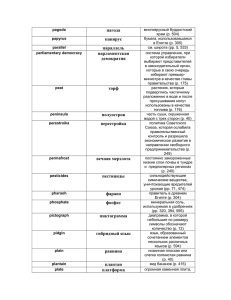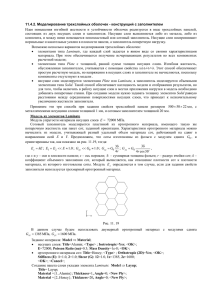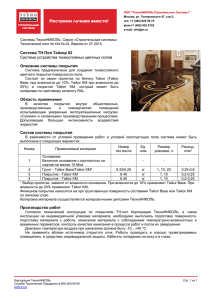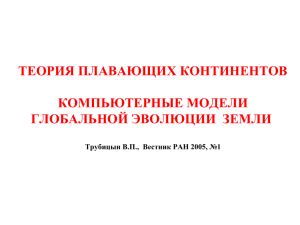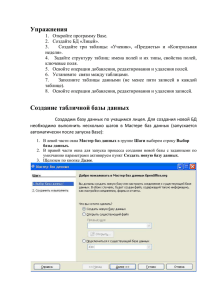DEFORMATION OF LONG- LENGTH EXPLOCLAD SHEETS: MATHEMATICAL MODELING
реклама
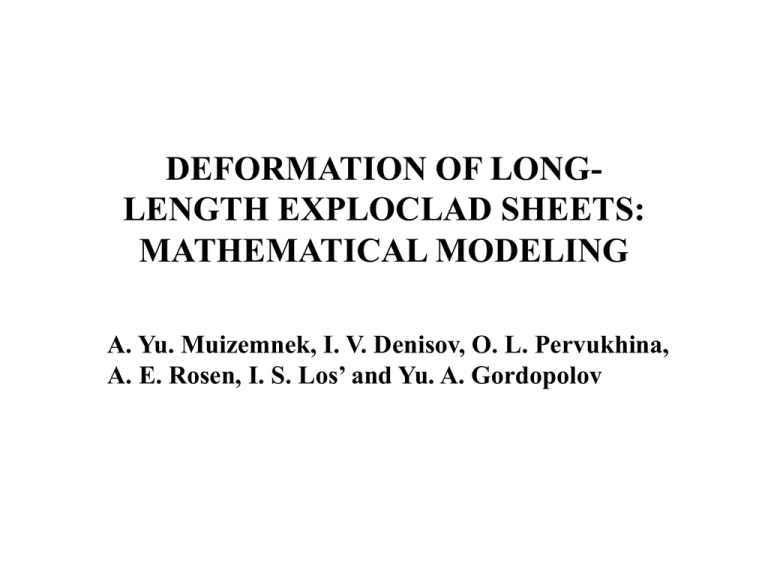
DEFORMATION OF LONGLENGTH EXPLOCLAD SHEETS: MATHEMATICAL MODELING А. Yu. Muizemnek, I. V. Denisov, О. L. Pervukhina, А. Е. Rosen, I. S. Los’ and Yu. A. Gordopolov 2 Object: Experimentally-theoretical research of longitudinal deformations of making layers of a multilayer material at explosion welding Research Technique 1. Computer simulation of deformation process of large-size sheets at explosion welding by means of LS-DYNA. 2. Experimental research of large-size sheets deformation by means of fixed points method. 3. Analysis of computer simulation and experimental results. 3 Explosion welding scheme 1 – clad plate ; 2 – base plate ; 3 – air technological gap ; 4 - sand background Initial data The geometrical sizes Thickness, mm Length, mm Width, mm clad plate 4 6000 1500 base plate 26 5900 1500 gap 8 explosive 50 5900 1400 sand background 100 5900 1400 PHYSICOMECHANICAL PROPERTIES OF MATERIALS Steel plate: – Density ρ = 7800 kg/m3; – Young modulus E = 192 GPa; – Yield strength σт = 350 MPa; – ultimate strength σв = 500 MPa; – unit elongation δ = 21%; – coefficient of thermal expansion α = 11,4 ºС-1 (100ºС). Explosive - apparent density ρВВ = 740 kg/m3 - velocity of detonation D = 2100 m/s. Sand - apparent density ρпес = 2800 kg/m3 - compression strength σсж = 140 MPa 4 Mathematical simulation by means of LS-DYNA software for the following situations : 1. Porous background, dissimilar metals (steel+stainless steel) under the assumption that both plates material behaves as a solid body, technological gap between clad and base plates. 2. Porous background, dissimilar metals, under the assumption that a clad material behaves as a liquid, a base material behaves as a solid body, technological gap between clad and base plates. 5 The description of used finite-element mesh – Quantity of elements ~ 1000000 ; – Quantity of units ~ 2000000 ; – The maximal size of an element – 0.5 mm. Finite-element mesh Used models of materials and state equations. Explosive : – material model - #9 (Wilkins-Geyrouch); – state equation - # 2 (JWL). Metal plate : – material model - #15 (Johnson – Cook); – state equation - # 4 (Mi – Gruneisen); Sand background : – zero-material - #9; – state equation of porous material - # 8. Technological gap : – vacuum model - #140. 6 The first variant of calculation Porous background, dissimilar metals under the assumption that both plates material behaves as a solid body, technological gap between clad and base plates. a b Distribution of material density in calculation area at t = 3 ms: a – the beginning clad process; b – the termination clad process It is established that the left butt of clad and base plates is extended by 16,1 mm and 29 mm. The right butt of clad and base plates is extended by 71 mm and 61,3 mm accordingly. 7 The second variant of calculation Porous background, dissimilar metals, under the assumption that a clad material behaves as a liquid (base material behaves as a solid body), technological gap between clad and base plates a b Distribution of material density in calculation area at t = 3 ms a – the beginning clad process; b – the termination clad process It is established that clad plate isn’t extended and base plate is extended by 35 mm. 8 clad plate 1 base plate t = 1000 μs t = 1500 μs t = 2000 μs Change of pressure longitudinal along sheets 2 9 clad plate 1 base plate t = 2500 μs t = 2750 μs t = 3000 μs Change of longitudinal stress along the sheets 2 10 The scheme of sheet deformation revealing after explosion welding Before explosion welding The beginning of initiation clad plate Matching clad and base plates base plate Labels After explosion welding The beginning of initiation clad plate base plate Places of matching clad and base plates Labels 11 Results of experiments Before explosion welding After explosion welding Matching clad and base plates The top view 12 The generalized results of explosion welding simulation Plate base clad base clad base Moving from the initiation point Variant of calculation Experimental data at V0=2100 km/s 1 2 to the right, mm 16,1 0 0 to the right, mm 29 0 0 to the left, mm 61,3 35 25 – 28 to the left, mm 71 0 0 1500 1300 1200 the beginning of process of lengthening, mm Conclusions: 1. On the deformation behavior and change of geometric sizes of clad and base sheet influence the next parameters: – the initial geometric size of plates; – characteristics of physical-mechanical properties of welded plates materials and explosive. 2. The residual elongation of plates occurs nonuniformly from 80% of sheet length. The maximal residual deformation is near the opposite butt from the initiation point. 3. Calculation and experimental results showed that the clad sheet behaves as a viscous liquid and the base sheet behaves as a metal in solid state. 4. Tensile deformation of base sheet due to the impact of clad sheet goes ahead of the contact point along the full thickness to the joint formation. Consequently explosion welding at the end areas goes along the moving surface of base sheet. Анимация 2. Движение материала в расчётной области (Начало процесса сварки) Анимация 3. Движение материала в расчётной области (окончание процесса сварки) Для описания поведения материалов листов была использована модель Джонсона-Кука со следующими значениями параметров модели: $ *MAT_JOHNSON_COOK $---+----1----+----2----+----3----+----4----+----5----+----6----+----7----+----8 $ mid ro g e pr dtf vp 4 7.8 0.808 2.03 0.300 0.0 0.0 $---+----1----+----2----+----3----+----4----+----5----+----6----+----7----+----8 $ A B n c m tm tr epso 350.25E-5 275.0E-5 0.36 0.022 1.0 1400.0 30.0 1.0e-5 $---+----1----+----2----+----3----+----4----+----5----+----6----+----7----+----8 $ cp pc SPALL IT D1 D2 D3 D4 477.0E-8 0.0 0.0 1.0 100.0 0.0 0.0 0.0 $---+----1----+----2----+----3----+----4----+----5----+----6----+----7----+----8 $ D5 0.0 $ *EOS_LINEAR_POLYNOMIAL $---+----1----+----2----+----3----+----4----+----5----+----6----+----7----+----8 $ eosid c0 c1 c2 c3 c4 c5 c6 4 0.0 1.4 0.0 0.0 0.0 0.0 0.0 $---+----1----+----2----+----3----+----4----+----5----+----6----+----7----+----8 $ e0 v0 0.0000000 1.0 $ MID – идентификатор материала в виде уникального номера; RO – массовая плотность; G – модуль сдвига; SIGY – предел текучести; PC – предельное давление при растяжении; SPALL – тип разрушения; EPS – эффективная пластическая деформация; ES – эффективное напряжение; EOSID – метка уравнения состояния; Е0 – начальная внутренняя энергия; V0 – начальный относительный объем. Для описания поведения ВВ была использована модель MAT_HIGH_EXPLOSIVE_BURN и уравнение состояния JWL со следующими значениями параметров модели: $ *MAT_HIGH_EXPLOSIVE_BURN $---+----1----+----2----+----3----+----4----+----5----+----6----+----7----+----8 $ mid ro D PCJ BETA K G SIGY 5 0.740 0.2100 0.01360 0.0000000 0.0000000 0.0000000 0.0000000 $ *EOS_JWL $---+----1----+----2----+----3----+----4----+----5----+----6----+----7----+----8 $ eosid a b r1 r2 omeg e0 v0 5 0.06142 0.01352 5.4 1.4 0.25 0.00673 1.0 $ MID – идентификатор материала в виде уникального числа; RO – массовая плотность; D – скорость детонации; PCJ – давление Чэпмена-Жуге; EOSID – метка уровня состояния; V0 – начальный относительный объем. Для описания поведения песка была использована модель MAT_NULL для пористого материала со следующими значениями параметров: $ *MAT_NULL $---+----1----+----2----+----3----+----4----+----5----+----6----+----7----+----8 $ mid ro pc mu terod cerod ym pr 6 2.5 0.00 0.0e+3 1.0e-5 0.00 $ *EOS_TABULATED_COMPACTION $---+----1----+----2----+----3----+----4----+----5----+----6----+----7----+----8 $ eosid gama e0 v0 6 0.0 0.0 1.0 $------+-------1-------+-------2-------+-------3-------+-------4-------+-------5 $ ev1 ev2 ev3 ev4 ev5 0.0 -0.04 -0.08 -0.12 -0.16 $ ev6 ev7 ev8 ev9 ev10 -0.20 -0.24 -0.28 -0.32 -0.36 $ c1 c2 c3 c4 c5 0.8e-11 0.8e-4 2.4e-4 5.6e-4 12.0e-4 $ c6 c7 c8 c9 c10 24.8e-4 50.5e-4 101.6e-4 204.0e-4 409.0e-4 $ t1 t2 t3 t4 t5 0.0e+6 0.0e+6 0.0e+6 0.0e+6 0.0e+6 $ t6 t7 t8 t9 t10 0.0e+6 0.0e+6 0.0e+6 0.0e+6 0.0e+6 $ k1 k2 k3 k4 k5 40.0e-4 40.0e-4 80.0e-4 160.0e-4 320.0e-4 $ k6 k7 k8 k9 k10 640.0e-4 1280.0e-4 2560.0e-4 5120.0e-4 10240.0e-4 $ MID – идентификатор материала в виде уникального номера; RO – массовая плотность; PC – предельное давление при растяжении; MU – коэффициент вязкости; TEROD – относительный объем для разрушения при растяжении; GEROD – относительный объем для разрушения при сжатии; YM – модуль Юнга (используется только для нулевых балочных и оболочечных элементов); PR – коэффициент Пуассона (используется только для нулевых балочных и оболочечных элементов). Выражение Джонсона (Johnson) и Кука (Cook) для напряжения текучести . p n y A B 1 c ln *1 T *m Уравнение состояния JWL задает давление в виде R1V R2V E e e p A1 B1 R V R V V 1 2
